IN THIS ISSUE
- Joro Watch is on
- Comeback kestrels
- Monitoring manatees
- Yard aid for fall migrants
 Female Joro spider (Anna Yellin/DNR)
With Joro spiders spreading across Georgia and beyond, a new website is helping track the big arachnids from Asia.
Joro Watch, developed by the University of Georgia, Valdosta State University and Southern Integrated Pest Management Center, is one-stop portal to report and learn about the potentially invasive species. Included is a guide to sorting out Joros from native look-alikes such as golden silk orb-weavers and yellow garden spiders.
The monitoring program is aimed at gathering data and better understanding the spread and distribution of Joros.
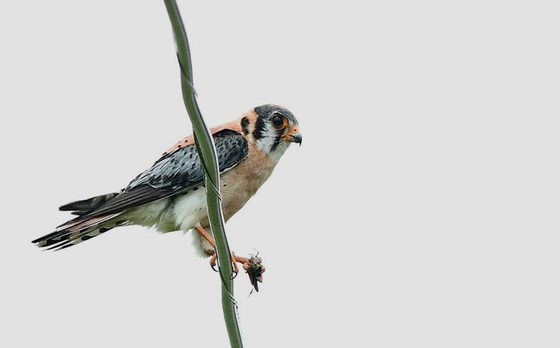 Adult male southeastern American kestrel (Florida FWC)
By ETHAN HATCHETT
Just outside the small middle Georgia town of Butler, the southeastern subspecies of American kestrel has avoided extirpation – for now.
The sandhills and forests near the Taylor County community boasted 70 successful nests and 116 chicks fledged this summer.
Those encouraging totals mark the culmination of 17 years of work by biologists and volunteers to ensure that Georgia has at least one healthy population of these tiny raptors, North America’s smallest falcon.
“Before our restoration effort, the kestrels were on a slow slide towards extinction,” said Nathan Klaus, a senior DNR wildlife biologist.
The southeastern American kestrel is unique in several ways. Unlike its northern counterparts, it is nonmigratory, spending its life in the southeastern U.S. The subspecies has strict habitat requirements. It thrives in open pine savannas, naturally nesting in cavities abandoned by the red-cockaded woodpecker, a threatened species. Commonly called sparrowhawks, kestrels are also an apex predator in this ecosystem (watch).
So why the decline? Find out in our blog post “Sparrowhawks make a comeback.”
INCOMING KESTRELS
While the southeastern American kestrel is preparing to winter at home, other kestrels from Canada and the northern U.S. are migrating south, seeking warmer climates. Some will spend the winter in Georgia – from the upper Piedmont region to the coast – while others will travel all the way to Central America.
Look for these far-flung kestrels from mid-September into winter on powerlines and along field edges.
 Manatee being assessed (Monica Ross/Clearwater Marine Aquarium, USFWS permit MA37808A-2)
Here’s hoping O’Dare and Sammy G help reveal how sea cows navigate the massive Port of Savannah.
Last month on the Savannah National Wildlife Refuge, a crew including DNR and partners caught the manatees, checked their health and fitted each with a GPS-linked satellite transmitter before easing them back into the murky water.
Now researchers – and the public – can see where O’Dare and Sammy G go. DNR senior wildlife biologist Clay George said the data could pinpoint risks and lead to improved protections for the federally protected mammals in one of the world’s busiest ports. More than 20 manatees have been found dead there from vessel collisions since 2000.
Manatees migrate from Florida to Georgia from spring into fall. The draw? Warming waters and abundant marsh grass and other food sources.
DNR, Clearwater Marine Aquarium and Georgia Aquarium began tracking the animals in 2015 near Kings Bay Naval Submarine Base. The recent move from St. Marys to Savannah targeted manatees that migrate farther north to provide a clearer picture of their travel patterns, habitat use, health and threats. In all, more than 30 manatees have been tagged.
Others involved last month included the U.S. Fish and Wildlife Service and Florida’s Freshwater Fish and Wildlife Conservation Commission. The Navy and National Park Service also have supported the project.
MORE FROM SAVANNAH: LISTENING FOR WHALES
Woods Hole Oceanographic Institution and shipping company CMA CGM have launched an acoustic monitoring buoy off Savannah to help detect endangered North Atlantic right whales in the high-traffic waters. Updates.
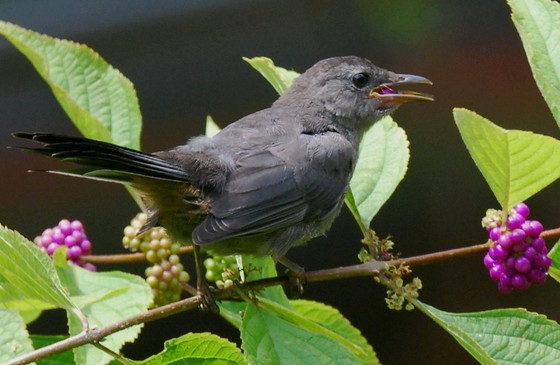 Gray catbird eating American beautyberry (Terry W. Johnson)
By TERRY W. JOHNSON
The population declines of neotropical migratory birds are well documented.
Neotropical migrants are birds that nest throughout North America and winter in Latin America. This colorful kaleidoscope includes orioles, warblers, vireos, thrushes, tanagers and other songsters.
Biologists once thought that habitat losses on winter and breeding grounds were the most serious threat faced by many of these birds. However, research in recent decades suggests that a dramatic loss in suitable stopover areas used by the birds during migration is also playing a key role in their alarming population losses.
Here’s where you come in. Your yard can help these migrants by providing a vital stopover site where the birds can rest and refuel before continuing journey. ...
Learn what you can do in this reprint of an Out My Backdoor classic.
Terry W. Johnson is a retired DNR program manager and executive director of TERN, friends group of the agency's Wildlife Conservation Section. Check out past columns, his Backyard Wildlife Connection blog and book “A Journey of Discovery: Monroe County Outdoors.” Permission is required to reprint a column.
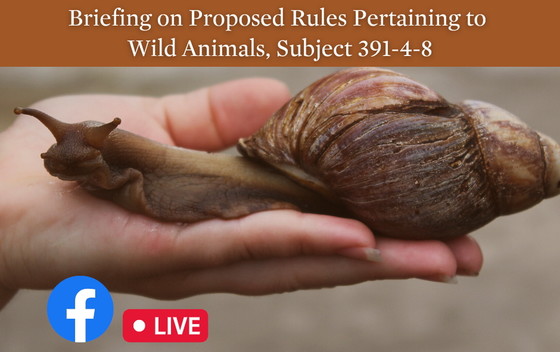 The Georgia Board of Natural Resources is considering changes to the state’s “wild animal” list that would add species, from monk parakeets to Argentine black and white tegus, that pose a threat to people or native wildlife. DNR will explain the changes in a virtual meeting at 7 tonight on Facebook. The public can submit comments by email, mail or phone by Sept. 30. Details.
In this year's survey of Georgia Wild readers– yep, that's you! – 82 percent of respondents said they had told others about an e-news item at least once, 95 percent agreed the newsletter informs them about conservation and 80 percent had been spurred to learn more about a species or issue (nearly a fifth were moved to financially support wildlife conservation in the state). Meanwhile, 10 survey takers from Midway to Smyrna were drawn to receive a DNR cap. (What's a good way to support the work featured in Georgia Wild? Buy a DNR eagle or monarch license plate or renew either of these or a hummingbird tag.)
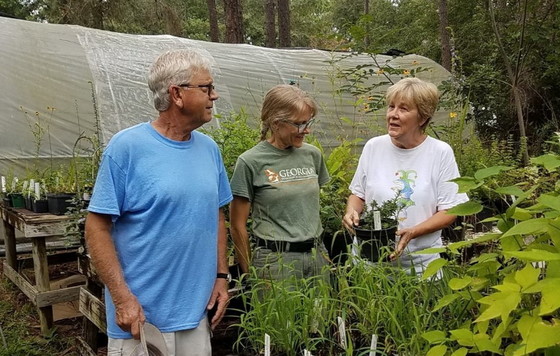 Native Plant Society's Paul Sumner and Amy Heidt with DNR botanist Lisa Kruse (center)
A recent rare-plant rescue highlighted teamwork between DNR, the Georgia Native Plant Society and the Georgia Department of Transportation. Alerted by DOT this summer about Twiggs County transportation work that would displace trilliums, skullcaps and milkvines, the Native Plant Society’s Amy Heidt and Paul Sumner of Chula coordinated with other volunteers to dig up more than 300 plants and care for them until DNR could take the plants to the State Botanical Garden of Georgia, where they are being kept for research and relocation.
In the fall, bears eat like, well, bears. In a gorge-now, sleep-later approach called hyperphagia, even those that don’t hibernate will consume 10 times more calories than normal, adding crucial fat before they retire to their winter dens. Here’s how to make sure their feeding sprees don’t include your yard.
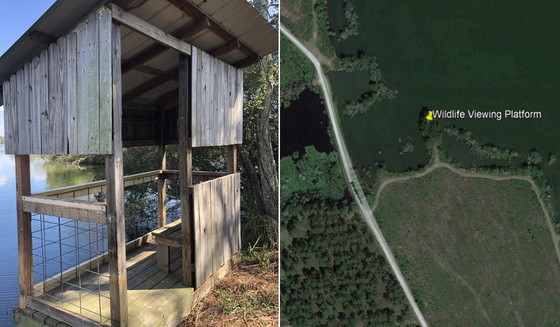 Renovated Paradise PFA viewing platform and site map (Bert Deener/DNR)
How’s the view at Paradise? Interesting – with opportunities to see everything from anhingas and ospreys to ducks and turtles – and more comfortable after staff at the DNR public fishing area near Enigma repaired the viewing blind on Lake Patrick, even adding a wire screen for air flow. (See the PFA kiosk for maps.)
Wildlife viewing is one of the fastest-growing outdoor activities in the U.S. A webinar at 1 p.m. Thursday will explore a new national and regional survey by the Dayer Human Dimensions Lab at Virginia Tech and an Association of Fish and Wildlife Agencies working group that digs deep into wildlife viewing and participants' perspectives. Sign up for the webinar.
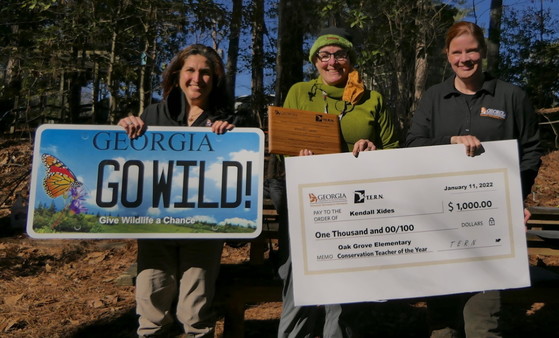 2021 teacher grant recipient Kendall Xides (center) of Dekalb County with DNR staff (Oak Grove Elementary)
Quick hits:
- Know a K-5th-grade Georgia educator who is keen on teaching life sciences and could use $1,000 to help do it (not to mention the recognition that comes from receiving DNR’s Conservation Teacher of the Year grant)?
- National Hunting and Fishing Day turns 50 this year, with events statewide Sept. 24 and no fishing license required for Georgians that Saturday.
- Some animals can help meet their habitat needs by making materials from their bodies, as part three of our Animal Architect series explains.
- CoastFest, a free celebration sporting touch tanks, wildlife booths and educational programs, is scheduled for Oct. 1 in Brunswick.
- At CoastFest, take a virtual tour of a research vessel and artificial reef via 360-degree videos and headsets with DNR's Coastal Resources Division.
-
A river-wide cleanup is planned for the Satilla Saturday, with boat landings targeted and the Satilla Riverkeeper open to crews tackling other sites.
 Eagles on the osprey nest platform at Fort Pulaski (left) and the juvenile after fledging (Pam Vercellone-Smith)
Names in the news: The story of Georgia’s first documented successful bald eagle nest on a human-made structure is told by Dr. Bob Sargent, a program manager with DNR’s Wildlife Conservation Section, and Savannah birder Pam Vercellone-Smith in the latest issue of The Oriole. As detailed in the Georgia Ornithological Society journal (the issue will be posted later), the eagles fended off ospreys to raise and fledge an eaglet on an osprey nest platform near the Fort Pulaski National Monument visitor center this year. DNR game warden 1st class Brock Hoyt has been named the agency’s Game Warden of the Year, with Cpl. Dean Gibson receiving the James R. Darnell Award as runner-up. Hoyt is assigned to Fulton County and Gibson to Talbot. Deron Davis is moving from executive director of The Nature Conservancy in Georgia to conservation project director for the organization’s North American region. Davis, who worked with the conservancy in Georgia for 12 years, “has been a true champion for Georgia’s environment,” DNR Commissioner Mark Williams said. DNR biologists have graced recent newsletter issues of the American Fisheries Society’s Georgia chapter, with biologist Matthew Rowe making the cover in August and colleague and chapter President-elect Ani Escobar profiled this month (page 18).
WHAT YOU MISSED ...
In the previous Georgia Wild:
- Yellow jacket season
- Mussel invader caught again
- Animal architects: the collectors
Top
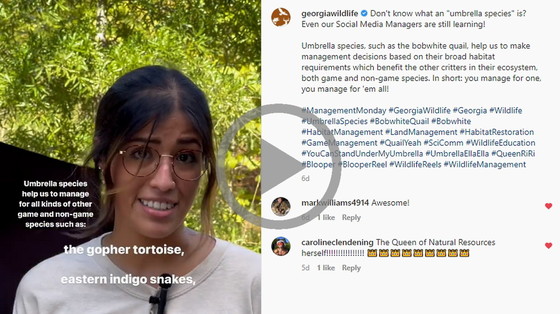 "Under My Umbrella," DNR Public Affairs staff explain umbrella species ;-)
"Extreme Home Makeover: Wildlife Resources Edition" (i.e., how Pittman-Robertson Act funds benefit game and nongame wildlife), DNR
(audio) "Snake Talk with Dr. Jenkins" podcast episodes on rattlesnake roundups: "John Jensen on transition to wildlife festivals" and DNR's "Daniel Sollenberger on the Whigham roundup," The Orianne Society
(audio) "Protecting whale superhighways," WBUR-FM (Boston)
Buck feeds on corn under the water, Georgia Outdoor News
Tour Clybel WMA's renovated shooting range, DNR
(audio) Athens News Matters interview with DNR's Dr. Bob Sargent about Georgia's record nesting season for bald eagles, WUGA-FM (91.7, 94.5, Athens)
"Judge strikes challenge by Maine, lobstermen to right whales rules," Maine Public Radio. Related: "NOAA asked to expand comment period" (The Brunswick News); "Seafood group 'red lists' lobster" (Portland Press Herald, Maine); "DNR biologist reflects on right whales, recommends protections" (SaportaReport).
"Fate of mine near Okefenokee could soon be determined by EPD," Georgia Public Broadcasting. Related: "Study raises concerns," The Brunswick News.
"Bird flu outbreak kills hundreds of vultures," Axios (Atlanta) and others. Related: Associated Press.
"Preservation of Ceylon key state conservation project," The Albany Herald and others. Also: "State, partners step in to save Ceylon," Bryan County News.
"DNR to award $1000 grant to top conservation teacher," Dawson County News, Jackson Herald and others.
"Georgia Audubon celebrates native birds, plants in September," Reporter Newspapers, Atlanta
"$7.5 million awarded in grants to restore longleaf pine ecosystem," National Fish and Wildlife Foundation
"How Facebook is saving snakes," Scientific American
"A good year for several once-scarce species," The Atlanta Journal-Constitution
"'Shockingly weird' reason mosquitoes find us," Science Alert (study: Current Opinion in Insect Science)
"DNR announces 11 Recreational Trails grants," The Clayton Tribune
"California man pleads guilty to smuggling 1,700 animals," Associated Press
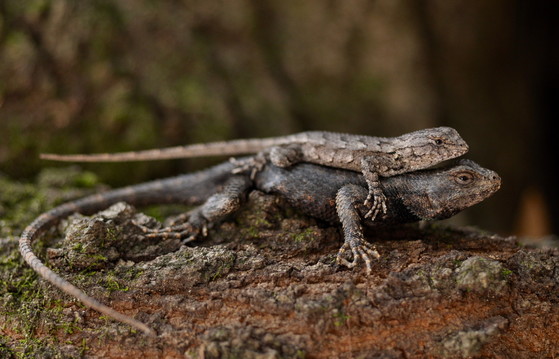 These two are mating but fence lizards are most often seen waiting – to ambush prey. (Mark Krist)
Which Georgia reptile is known for its speed, charm and spikes? Why, the eastern fence lizard. Read more about these common yet charismatic critters.
CREDIT
Masthead: Manatee feeding on marsh grass (DNR)
Top
|